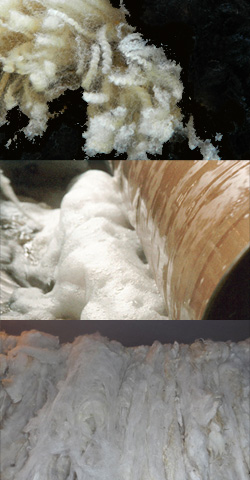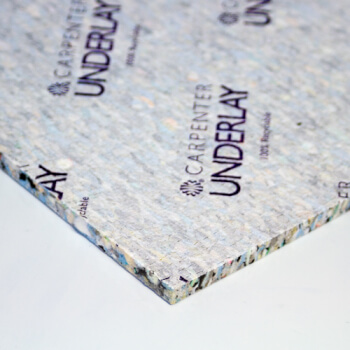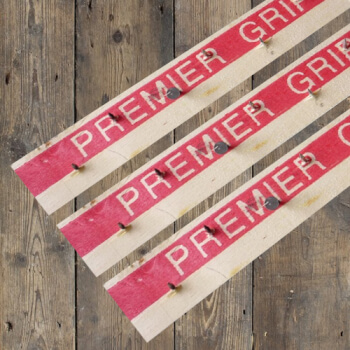How Is A Wool Carpet Made?
By Jim (21/11/2016)
Hello everyone!
Wool is one of the first materials ever used by humans - it’s been with us since the dawn of civilization; the first evidence of sheep being domesticated for wool was around 11,000BCE to 9,000BCE in Mesopotamia. The first wool production in Europe is thought to have been around 6000BCE in France, in the region near modern-day Marseille. And although we have increased the scale on which we manufacture wool goods and improved the tools we use, the actual process has changed very little - so here we present the full life cycle of a wool carpet. Enjoy!
1. Sheep
The first part of the process - naturally - is to get some sheep.
Not all sheep have wool which is suitable for textiles, and even fewer breeds produce the coarse, hardy wool needed for carpets.
The best breeds for this tend to be mountain sheep with thick, tough fleeces. Several of these are raised in Britain like the Herdwick, the Scottish Blackface, the Rough Fell and the South Wales Mountain - more about sheep (and what their wool is used for) can be found on the British Wool Marking Board Website.
Lots of great carpet wool is produced in Britain - Brintons are proud to support British wool, and boast that 1 in 9 British fleeces go into their carpets!

2. Shearing
Image: Fleece by Free Hand Farm
Once the sheep are ready (this can come at different times of the year depending on the breed and the climate) they are shorn, their fleeces removed and ‘skirted’ i.e. those parts too dirty to be efficiently cleaned are removed, typically the legs and belly area.
3. Washing and Scouring
Image: Wool Scouring by CSIRO [CC BY 3.0] via Wikimedia
The fleece is then washed -the process is complex and delicate; care must be taken that the wool isn't agitated too much, or it will ‘felt’, the fibres matting together into clumps.
The particular type of washing done for industry is ‘scouring’ - this removes lanolin (a naturally occurring water-resistant wax) making the wool suitable for textile use. Lanolin is used in many things, including as an ointment to treat skin conditions - but not carpet!
4. Picking
Image:Scoured Wool by
Şahzadə [CC BY-SA 3.0] via Wikimedia
Once the wool has been scoured, it goes through a process of ‘picking’ - this process separates the groups of fibres into small pieces. Again this has to be handled very gently to prevent felting. This is the part of the process when you might consider adding nylon fibres to the mix in order to strengthen the finished product, as Westex (who specialise in 80/20 wool and nylon carpets) do for theirs.
5. Carding
Picking is followed up with ‘carding’, running the wool over a surface covered with tiny metal rods - rather like a hairbrush - which helps to further tease out and disentangle the individual strands. This make them into a more consistent, uniform material, sometimes referred to as a net or web, which is then divided into small strips called ‘pencil roving’.
Carding was once done with small carding combs - again, rather like hair-brushes for pets - but is completed on huge machine-powered rolls.
6. Spinning
Once the wool has been divided into roving, it is spun - the roving is gently removed from the rolls and transferred to smaller spools.
This is then twisted to make yarn; by twisting several thin strands together, thicker, heavier yarn can be created - the number of strands translates to the ‘ply’ - for example, 3 ply yarn is made up of three smaller strands. Most carpet yarn is two or three ply, which has more resistance to flattening and wear than single-ply yarn.
The amount and consistency of the twist within the yarn also affects its resilience, as explained in our previous blog about choosing carpet, so this will be the time when the manufacturer specifies the number of twists per inch - however it is possible to over-twist yarn, adding too much tension or distributing tension unevenly, causing it to knot up, which is not ideal for carpets.
7. Dyeing
Once the wool has been turned into yarn and spooled onto bobbins, it is dyed - it is usually placed in vats of dye mixed with water, and heated to high temperatures to help ‘set’ the colour. Dyes for wool are almost always acidic, as this helps the dye bond with the fibre at a chemical level and improve colour ‘fastness’ i.e. its ability to resist running or become ‘washed out’ over time. Alkaline dyes, more commonly used for cotton or synthetics, will damage wool, so they are rarely if ever used.
8. Construction
Now you have your coloured yarn, it’s time to make the carpet!
For this you will need some heavy machinery, and what you use will depend on what kind of carpet you want to make. As we have covered in previous blogs, there are two main ways to construct carpet - tufting and weaving.
Tufted carpet, the most common, requires the yarn to be ‘punched’ into a sheet of fabric known as the ‘primary backing’, and then cut to form a twist pile or knotted again to make a loop pile. Tufting Machines are produced only by a handful of manufacturers such as Cobble Van De Weile (formerly Cobble Brothers of Blackburne) and CMC (Card Monroe Corporation) - these behemoths can make around 2000 stitches per minute!
Woven carpet, on the other hand, requires an industrial loom to weave the backing and face threads simultaneously into the backing fabric.
This is a more traditional but more expensive type of carpet production, and again the machines are only made by a small number of companies - Van De Weile is a front runner in this as well, as are the Belgian company Costruma and Switzerland’s Stäubli.
9. Finishing
There are several process which ‘finish’ a carpet - for tufted construction, the primary backing is stuck to a ‘secondary backing’ with a powerful bonding agent, usually latex, which are sandwiched together in a press.
Woven carpet of course does not require backing but a thin layer of latex is usually applied to the backing for weight, helping the finished carpet to lay flat. In both instances the excess is removed and the carpet is placed in an ‘oven’ to cure the latex.
After this your lovely wool carpet is nearly finished - of course, there are more things you can do to it - Westex apply anti-stain and anti-insect treatments to all their carpets as standard, for example. And of course many manufacturers go through a thorough check of their carpets to make sure they are up to scratch!
10. Rolled and Sold

Image: Brintons' Warehouse ©Total Interior Storage Solutions
The finished carpets can be anything up to 37 meters (as we went into in our blog ‘What Is A Carpet Remnant’) at set widths - usually 4 or 5 metres. These a rolled up and stored, wrapped in plastic, until a retailer or business orders a cut.
When there is only a small part of the large roll left it is classified as a remnant; there is no official size where this becomes the case, it is simply at the manufacturer's discretion.
And then of course the remnants are sent to folks like us, where we can offer them to you!
So there you go- there are, of course, many other subtle parts to this story we haven’t covered here today - but hopefully now it’s clearer just how complex and skilled the manufacture of wool carpet is, and how each stage of the process contributes to giving you a brilliant, high quality product. With thanks to the British Wool Marketing Board for their help on this blog!
Enter your required size for our most accurate pricing and availability.










